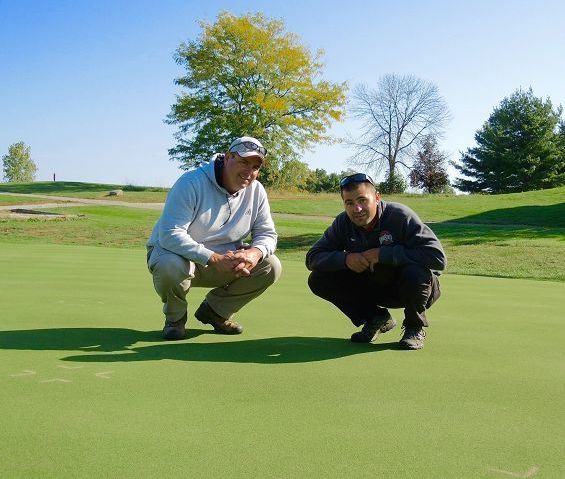OSU ATI builds research green at Hawk's Nest
Although the Hawkins family donated Hawk's Nest Golf Club in Creston to Ohio State University's Agricultural Technical Institute back in 2007, this year's addition of a new faculty member and the installation of a research green make a statement for the value of the Turfgrass Management Program.
Zane Raudenbush joined the OSU/ATI faculty earlier this year after completing a Ph.D. in horticulture from Kansas State University, and by March he was busy tending to a new research green visible from Cleveland Road at the 18-hole golf course.
Amy Raudenbush said she feels the competition for her husband's attention as he makes his daily visits to baby his meticulously maintained green, and he admits he loves what he does and is happy to share his passion with ATI students.
ATI’s Turfgrass Management Program began in 1974, and when the Hawkins family made their generous donation to OSU in 2007, Raudenbush said,
“It was with the intent that it would be used as a teaching resource. The mission at Ohio State ATI is to learn by doing, and the grounds at Hawk's Nest provide a unique opportunity to give our students hands-on, practical experience.”
While it is obvious how the gift of this 72-par course, worth about $4.6 million, will benefit students with the career goal of golf course maintenance, students in other programs can take advantage of learning opportunities at the public course. Undergraduates in business, horticultural, landscape and environmental science have opportunities to gain real-world experience on-site as well.
Golf course superintendent Mark Smith has been at Hawk's Nest since 1994 and played an integral role in the transition of the golf course's ownership.
Smith said, “We have integration with students now that Zane is on board. Students are building and fixing things. It's hard to teach problem-solving skills in class. Pencil and paper analysis isn't enough. We don't live in a classroom.”
Smith explained how the students learn to deal with weather, irrigation and mowing without disturbing players.
Raudenbush, who also teaches exploring horticulture and golf course organization and management, agreed with Smith. “It's nice to be out here where they get the real-world aspect. They are integrated with it,” he said. “There are a lot of the tangibles that can't be taught in the class.”
With approximately 50 million acres of managed turfgrass in the United States, it is the third largest crop in total acreage in the country and a nearly $40 billion industry, according to Raudenbush, who has some students who have already sallied forth into the field.
First-year student Justin Lorentz said, “I have a lawn care business and want to expand and learn more about the turf.”
Students Mark Chistopherson and Kyle Gray also are attending Raudenbush's classes because they want to learn more about the horticultural aspects of the turf for better maintenance, and being on-site at the golf course has proved to be a valuable aspect of the classes.
“It's nice having hands-on experience. It's one thing to say how to do something, but doing it shows you the theory behind it,” Gray said.
Students in ATI's Turf Club are willing to expand their learning experiences while helping others because one of the missions of their club is “to volunteer in the community.”
“I drive around Wooster and see countless opportunities for the Turf Club to make a positive contribution,” Raudenbush said. “Most notably our students are capable of improving some of the youth sports fields that may not have the infrastructure or budget to carry out all of the necessary maintenance. These opportunities are win-win situations because our students gain invaluable practical experience while also giving back to the community.”
Through classes and paid internships ATI students are well on their way to obtaining marketable skills. “In our industry experience is key,” Raudenbush said.

